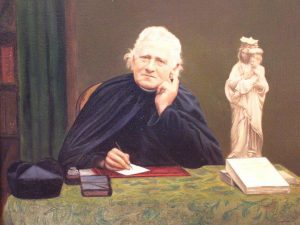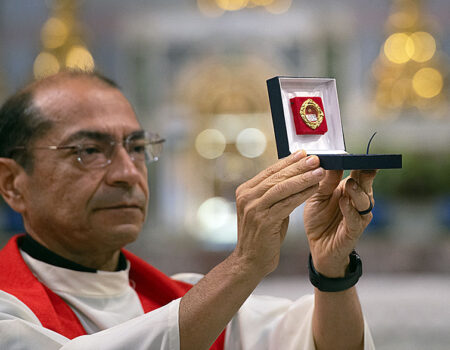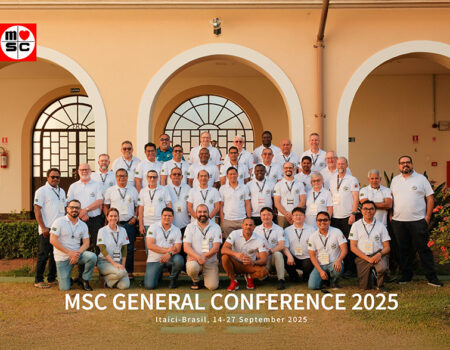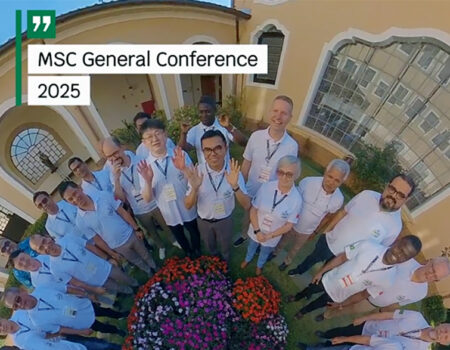JULES CHEVALIER
 When today we use the name “Chevalier Family”, we are referring to a French priest, Father Jules Chevalier.
When today we use the name “Chevalier Family”, we are referring to a French priest, Father Jules Chevalier.
He was not born great. His life was not a mystery. He was like any of us ordinary individuals. What made his life remarkable however was his vision of proclaiming God’s love to the world. He became a man with a mission.
He was born in Richelieu, in Central France, on 15 March 1824, the third child of poor parents, Jean-Charles and Louise. His father was not very pious, but his mother was a devout woman. She taught Jules how to temper the ardent and impetuous character he inherited from his father by good humor, courage, and tenacity.
At twelve years old, shortly after his first communion, he expressed the desire to become a priest. As his parents didn’t have enough money to afford his education, Jules took up a job as an apprentice to a shoemaker and saved the money he earned.
In March 1841, his family moved to a small village 130 km away called Vatan, about 20 km north of the town of Issoudun and where his father was hired as a caretaker of a forest by a wealthy landowner. Hearing that Jules was interested in becoming a priest, this man undertook to pay Jules’ fees at the seminary. It was during his seminary days, that Jules Chevalier first dreamed of a group of people dedicated to the Heart of Jesus who would bring a message of love and hope to a world in which there was a complete indifference to God and an antagonism to any form of religion and a general feeling of hopelessness and despair. In preparation to enter the minor seminary, Jules learnt Latin from the local parish priest, walking about 4 km every day to attends his study. At the age of 17 he bade farewell to his family and entered Saint-Gaultier minor seminary.
A particular moment in Chevalier’s time in the seminary brought his vocation into sharper focus. When on an outing with other students, three of them decided to take a short cut down the mountain, they slipped on the snow and fell, two of them clung to trees, but Chevalier fell to the bottom and was thought to be dead. His body laid out in a nearby chateau was being mourned by his fellow students, when to their surprise “the corpse” heaved a great sigh! They carried him back alive to the seminary. Despite the humorous aspects to this episode, this was for Chevalier a significant life-changing experience, that being so close to death, he was brought to a greater attention to God’s providence in his life and the need to respond wholeheartedly to it.
In 1846 Jules entered the major seminary in Bourges. In the course of his seminary studies, his Sulpician professors introduced him to devotion to the Sacred Heart of Jesus, a devotion focussed on God’s merciful love for human kind, manifested in the heart of his Son, Jesus, who gave his life that all might live, so much did he love us.
At the completion of his studies, Jules Chevalier was ordained a priest on 14 June 1851.
In 1856, he testified: “While I was still at the major seminary, reflecting one day on the sickness that was consuming our times, I conceived a plan, or rather the good God inspired me with the idea of founding a society of missionary priests who would work to heal this sickness… A voice I could not deny kept saying to me: You will succeed one day; God wants this work”.
In 1862 he wrote: “The heart of the Divine Master is the centre in which everything in the Old and New Testaments converge, the pivot around which everything in Catholicism turns, the sun of the Church, the soul of our souls, the source of our mysteries, the origin of our sacraments, the pledge of our reconciliation, the salvation of our world, the remedy of our ills. That is how I understand devotion to the Sacred Heart: it embraces everything, it is the answer to everything”.
After his ordination Father Jules Chevalier served as curate in three different parishes in quick succession, but in October of 1854, 30 years old, he was appointed to Saint Cyr, in Issoudun, regarded as the most de-Christianised town in the whole region.
A second curate appointed there was Fr. Emile Maugenest. Together in the seminary at Bourges, they established a student fraternity called the ‘Knights of the Sacred Heart’ dedicated to spreading devotion to the Sacred Heart and living from its values. Before long, these two classmates had the support of the parish priest, Fr. Crozat, to continue with this little work.
At Issoudun, the two young priests, determined to found a religious congregation and aware that they could be deluding themselves, sought to obtain a clear sign that this was what God wanted of them. They made a novena to the Blessed Virgin Mary that would conclude on the same day of papal definition of the doctrine of Mary’s Immaculate Conception, December 8, 1854. They would ask her to obtain a sign from her Son Jesus that their work was according to His will and that He would grant them the means to succeed in it. 
On December 8, 1854, their prayer was answered. After the Mass on that day, Fr. Jules received the message that an anonymous benefactor would give 20,000 francs for the construction of a house of missionaries to be established in the area with the approval of the Archbishop of Bourges. Again, on January 28, 1855, another benefactor promised to give 1000 francs yearly. The Archbishop saw this as the work of God, and so Father Chevalier began the foundation of his religious society of missionaries. By the end of 1856 Chevalier and Maugenest would complete their novitiate and make private vows in the presence of one witness: Fr. Charles Piperon, a friend from the seminary days who had come to join them.
The foundation was taking shape when the Cardinal Archbishop of Bourges, appointed Fr. Maugenest, under obedience as archpriest of the Cathedral. It was a blow to young community, leaving only Chevalier and Piperon. This event and others, along with Chevalier’s poverty of life and hard work, brought about signs of fatigue in Chevalier. However, encouragement came from a number of sources.
On ]uly 14th he had the privilege of an interview with the saintly Curé of Ars, John Vianney. This holy man told him that, although he had further trials ahead of him, his new society would be blessed by God and would do much good in the Church.
Later in the year, a visit to Paray- le-Monial, where Margaret Mary Alacoque had a vision of the Sacred Heart, gave him further confirmation in his vocation. On his return from Paray, says Fr. Piperon, he was “a new man”. Gone were his worries, to be replaced by a calm acceptance of whatever God’s will might be. From these encouragements he had drawn further inspiration and confirmation in his spirituality of the Heart of Christ.
In August 1860 he had a private audience with Pope Pius IX to whom he spoke of his religious congregation and the work he envisaged for it. The Pope listened kindly, praising his efforts to spread devotion to the Sacred Heart and giving his blessing to Fr. Chevalier’s work.
In 1861 the initial plans for a chapel of Our Lady of the Sacred Heart at Issoudun were made. In 1868 the first draft of the Constitutions of the new congregation was ready and were approved in 1869. Indeed, Jules Chevalier’s new society would be blessed by God and do much good in the Church, as the Curé of Ars had promised.
On August 30, 1874 a group of religious women, the Daughters of Our Lady of the Sacred Heart, was also founded by Father Chevalier.
A lay Confraternity of Our Lady of the Sacred Heart also started. With this foundation Jules Chevalier and his communities would nourish the laity and work to overcome religious indifference.
In 1874 the chapel was erected as a Minor Basilica, the statue of Our Lady of the Sacred Heart was crowned, and a place of pilgrimage begun.
Religious persecutions swept over France with the coming of the new Republic in 1879 and many MSC were moved from France to other countries. The Society of the Missionaries of the Sacred Heart grew from its humble beginnings with Jules Chevalier in rural Issoudun, to become a worldwide mission blessed by God and spreading everywhere the love of God made manifest to us in the Heart of Jesus.





